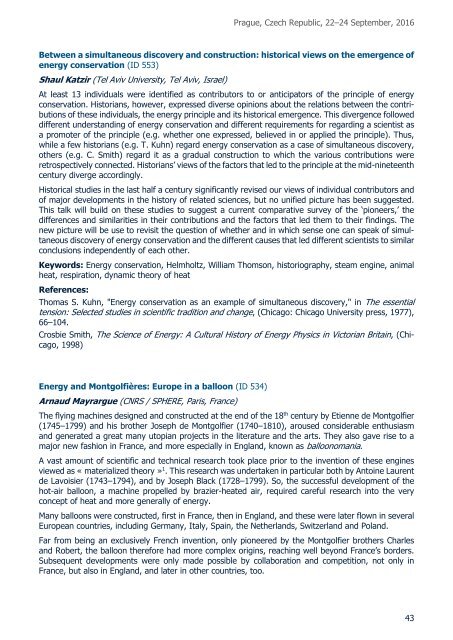7th ESHS Conference Prague 2016
7th Conference of the European Society for the History of Science Book of Abstracts
7th Conference of the European Society for the History of Science
Book of Abstracts
You also want an ePaper? Increase the reach of your titles
YUMPU automatically turns print PDFs into web optimized ePapers that Google loves.
<strong>Prague</strong>, Czech Republic, 22–24 September, <strong>2016</strong><br />
Between a simultaneous discovery and construction: historical views on the emergence of<br />
energy conservation (ID 553)<br />
Shaul Katzir (Tel Aviv University, Tel Aviv, Israel)<br />
At least 13 individuals were identified as contributors to or anticipators of the principle of energy<br />
conservation. Historians, however, expressed diverse opinions about the relations between the contributions<br />
of these individuals, the energy principle and its historical emergence. This divergence followed<br />
different understanding of energy conservation and different requirements for regarding a scientist as<br />
a promoter of the principle (e.g. whether one expressed, believed in or applied the principle). Thus,<br />
while a few historians (e.g. T. Kuhn) regard energy conservation as a case of simultaneous discovery,<br />
others (e.g. C. Smith) regard it as a gradual construction to which the various contributions were<br />
retrospectively connected. Historians’ views of the factors that led to the principle at the mid-nineteenth<br />
century diverge accordingly.<br />
Historical studies in the last half a century significantly revised our views of individual contributors and<br />
of major developments in the history of related sciences, but no unified picture has been suggested.<br />
This talk will build on these studies to suggest a current comparative survey of the ‘pioneers,’ the<br />
differences and similarities in their contributions and the factors that led them to their findings. The<br />
new picture will be use to revisit the question of whether and in which sense one can speak of simultaneous<br />
discovery of energy conservation and the different causes that led different scientists to similar<br />
conclusions independently of each other.<br />
Keywords: Energy conservation, Helmholtz, William Thomson, historiography, steam engine, animal<br />
heat, respiration, dynamic theory of heat<br />
References:<br />
Thomas S. Kuhn, "Energy conservation as an example of simultaneous discovery," in The essential<br />
tension: Selected studies in scientific tradition and change, (Chicago: Chicago University press, 1977),<br />
66–104.<br />
Crosbie Smith, The Science of Energy: A Cultural History of Energy Physics in Victorian Britain, (Chicago,<br />
1998)<br />
Energy and Montgolfières: Europe in a balloon (ID 534)<br />
Arnaud Mayrargue (CNRS / SPHERE, Paris, France)<br />
The flying machines designed and constructed at the end of the 18 th century by Etienne de Montgolfier<br />
(1745–1799) and his brother Joseph de Montgolfier (1740–1810), aroused considerable enthusiasm<br />
and generated a great many utopian projects in the literature and the arts. They also gave rise to a<br />
major new fashion in France, and more especially in England, known as balloonomania.<br />
A vast amount of scientific and technical research took place prior to the invention of these engines<br />
viewed as « materialized theory » 1 . This research was undertaken in particular both by Antoine Laurent<br />
de Lavoisier (1743–1794), and by Joseph Black (1728–1799). So, the successful development of the<br />
hot-air balloon, a machine propelled by brazier-heated air, required careful research into the very<br />
concept of heat and more generally of energy.<br />
Many balloons were constructed, first in France, then in England, and these were later flown in several<br />
European countries, including Germany, Italy, Spain, the Netherlands, Switzerland and Poland.<br />
Far from being an exclusively French invention, only pioneered by the Montgolfier brothers Charles<br />
and Robert, the balloon therefore had more complex origins, reaching well beyond France’s borders.<br />
Subsequent developments were only made possible by collaboration and competition, not only in<br />
France, but also in England, and later in other countries, too.<br />
43










